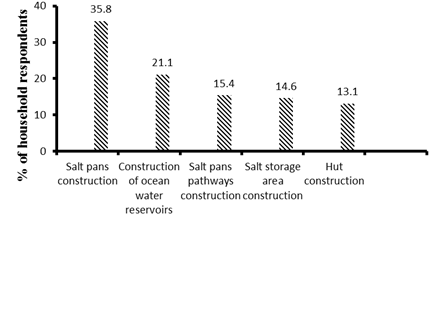
Effects of salt making on growth and stocking of mangrove forests of south western Indian Ocean coast in Tanzania
Abstract
Sustainability of mangrove forest is threatened by the ongoing high extent of degradation due to salt extraction. Information is lacking on the impact of degradation on growth and stocking of the mangrove forests in the tropical region including Tanzania. A study was carried out to identify destructive activities due to salt production and their effects on growth and stocking of mangrove species in Lindi municipality along the southern coast of the western Indian Ocean coast in Tanzania. Semi-structured interviews were randomly administered among 123 randomly selected salt pan owners and salt workers to identify the activities involved in salt making. Effects of salt making activities on growth and stocking of mangrove species were assessed using a transect walk. Results revealed that the most involved activities in salt production were construction of ocean water reservoirs (21.14%), salt pans (35.8%) and salt pans pathways construction (15.45%), salt storage area (14.63%) and huts construction (13.1%). Mangrove basal area and stocking were lower in areas with salt making activities with 0.74 m2/ha and 110 m2/ha respectively compared to areas without salt making activities (4.1m2/ha) and (266 m2/ha). We can conclude that salt making poses threat on the sustainability of mangrove forestry ecosystem.
Full Text:
PDFReferences
Ministry of Natural resource and Tourism (MNRT). The New Forest Act; Ministry of Natural Resources and Tourism; the United Republic of Tanzania. Forest act. 2002; (14) 174 p.
FAO. Global resource assessment; How are the world’s forests changing. Forestry.2015; 328. P
Hernández Cornejo, R., N. Koedam, A. RuizLuna, M. Troell, and F. Dahdouh-Guebas.. Remote sensing and ethnobotanical assessment of the mangrove forest changes in the Navachiste-San Ignacio-Macapule lagoon complex, Sinaloa,Mexico. Ecology and Society .2005; 10(1): 16.
FAO, (2005).Report on Global forest resources Assessment; the mastic study on mangroves, forestry Department FAO.Forestry resource.pp 30.
FAO. Main report on Global resource assessment. Forestry.2010; 56. P
Wang, Y.; Bonynge, G.; Nugranad, J.; Traber, M.; Ngusaru, A.; Tobey, J.; Hale, L.; Bowen, R; Makota, V. Remote sensing of mangrove change along the Tanzania Coast. Marine Geodesy 2003, 26, 35-48
VPO (Vice President’s office). Fifth National report on the implementation of the convention on biological diversity.Enviromental.2014; ISBN: 9987-8990-5-6 79
Wolchok, Lauren. Impacts of Salt Production on Pemba.(ISP).2006; Collection Paper 329.http://digital collections.sit.edu/isp_collection/329.73p
Farnsworth, E.J, and Ellison, M.J. The global conservation status of mangrove.Ambio Mangrove.1997: 26 (6) 328-334.
USAID (United States Agency for International Development) .Tanzania Environmental Threats and Opportunities Assessment. Enviromental.2012;145p.
Debajit Datta a,b,, R.N. Chattopadhyay c, P. Guha a.Community based mangrove management: A review on status and sustainability.Mangrove.2012; 107 (2012) 84e95
Samoilys, M.A, and Kanyange, N.W. Assessing links between marine and coastal people’s livelihoods: perceptions from Tanga, Tanzania, IUCN. 2008; Pp 30.
Semesi, A.K. Management Plan for the Mangrove Ecosystem of Mainland Tanzania.. Ministry of Tourism, Natural Resources and Environment, Forest and Bee-keeping Division, Dar es Salaam.1991; Vols. 1–10
Semesi, A.K.. Mangrove management and utilization in Eastern Africa. Ambio.1998;27(8):620–626.
IFAD. United Republic of Tanzania; Contry programme evaluation report. Agriculture.2014; 119.
UNEP Eastern Africa Atlas of Coastal Resources Tanzania, A project of the United Nations Environment Programme with the support of the Government of Belgium,Nairobi, Kenya.Coastal resource. 2001; 117p.
VPO (Vice President’s office).Report on the state of environment Tanzania.2006; ISBN: 9987-8990:161p.
Semesi, A.K. 1992. Developing management plans for the mangrove forest reserves of mainland, Tanzania. Hydrobiologia.1992; 247:1–10.
Semesi, A.K., Mgaya, Y.D. Y.D., Muruke, M.H.S., Francis, J., Mtolera, M. & Msumi, G. Coastal resources utilization and conservation issues in Bagamoyo, Tanzania.Ambio.1998. 27(8): 635–644.
IUCN Strategies for conservation and sustainable management of mangrove forest in Sierra Leone. Marine biology. 2007; 73 p
International Petroleum Industry Environmental Conservation Association (IPIECA). Report series on Biological impacts of oil pollution: mangroves. Biological scie. (1993); volume 24p.
Taylor, M. Ravilious, C. & Edmund P Green,P.E. Mangrove of east Africa; UNEP World 11.Conservation Monitoring Centre.Mangrove.2003;26p.
Refbacks
- There are currently no refbacks.
